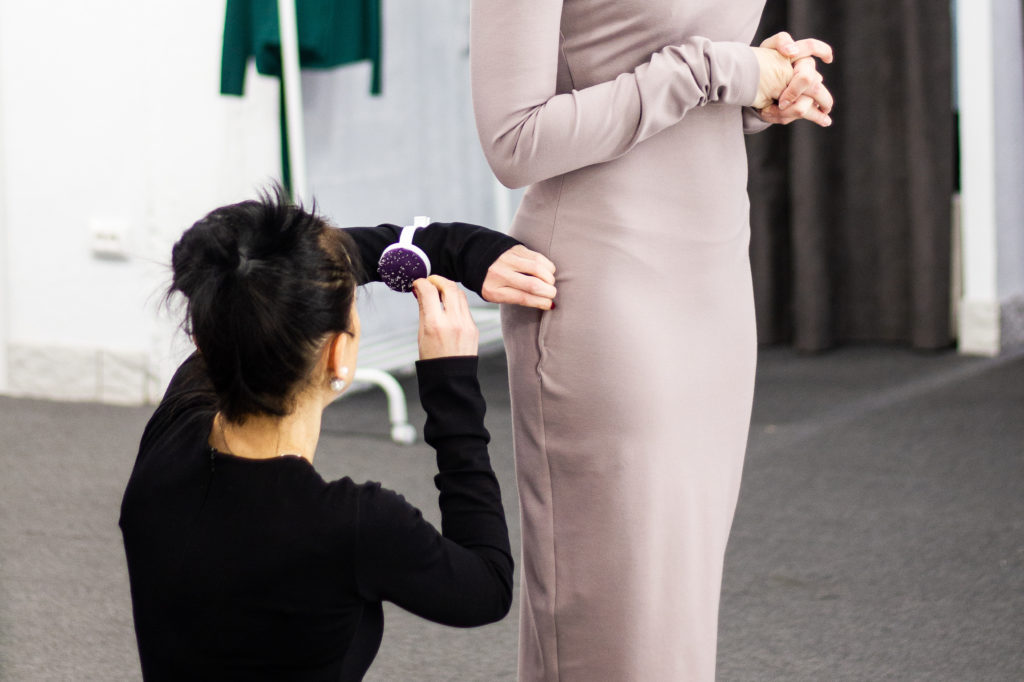We work with many of our clients remotely -- either because they live outside of the Chicago metro area, or these days so that we can avoid in-person meetings to prevent exposure and spread of COVID-19.
Video conferencing via Google Meet is great, we have the ability to see the garments on body live and talk through the fit adjustments with our clients. Fitting is a crucial part of the product development process, and being able to see the garments on the body we can see based on wrinkles or drag lines, where pattern adjustments need to be made to get a better looking garment. More than just moving seam lines or taking an item in/out or lengthening or shortening seams, many pattern revisions are more complex than that -- correcting a sleeve cap or adjusting the crotch curve on a pant for example. Often clients can communicate minor changes written or verbally, but lack the experience that we have to know more critical pattern changes.
Since it can be a challenge to see and communicate garment revisions when we’re not in the same room - we put together some tips to help ensure a better virtual session.
- Take measurements of your fit model before the session begins - especially in the case where you or a friend is your brand’s fit model, but even when using a professional model - it’s important to make sure the model’s measurements are consistent each time. Recording this and noting whether the model’s measurements have changed is helpful to refer to when determining which changes to make to the garment. If you are your own fit model, have someone else help you take your measurements to ensure they are accurate.
- Lighting and available space - Make sure you have a well-lit room, and space within your webcam’s view to show the entire garment. If it’s difficult to see something, it may not be addressed properly in the fitting and thus missed in the pattern revisions. If lighting during the meeting is difficult - the next tip can help.
- Take photographs in advance of the garment (front, back, side, and close-up of any problem areas). Send this in advance of the fit session if possible so we can address these areas in more detail together. Again if you are your own fit model, get a tripod and timer, or have someone else take the photos for you. This is especially important because you cannot necessarily see everything by looking down or over your shoulder in a mirror as you can when you stand naturally and straight on.
- Make notes in advance of the meeting that you want to talk through. The purpose of the session is to review fit, function, and fabrication. The more notes you prepare to review, the better your pattern maker can work with you during the session. These are all things to consider in a live in-person session as well.
- FIT: Do you notice any areas where the fit is off? Too big/small? Too tight/loose? Pay attention to neck size/shape, shoulders, sleeve length, placement of darts. On pants - is the waistband hitting at the correct spot on the body for your design? How does the crotch, hips, thigh, knee and leg opening look? Does the side seam fall straight or sway forward/backward? How’s the length?
- FUNCTION: Test any functional elements (or note if you need more time following the session) - including pockets, closures, or especially when designing a technical garment - test the garment by wearing it, not just trying it on. Are the pockets placed where they are natural to reach into? Is the pocket bag depth appropriate for the items that may be placed in them?
- FABRICATION: This category includes not only the actual material the garment is made from, but also any trim items, or construction methods used. This is a good time to note whether you need to add bar tacks for security, change out a trim element that isn’t working, or add top stitching to make a seam lay more smoothly or to make it appear more finished. Sometimes the fabric itself is changed during the design process because it doesn’t hang as you’d hoped, or isn’t serving the design in the desired way.
- Have your tools ready! You’ll need pins (safety or straight pins), chalk (or other marking tool), and a tape measure. Marking the garments during the session and sending them back to your pattern maker will further help ensure that all corrections are made accurately. Having a tape measure on hand is best vs. estimating how much you want to change something by.

Professional fit models can be hired to work virtually, or in-person with the pattern maker or the designer. They are trained and experienced in live sessions, and able to provide valuable feedback on the fit of the garment, as well as taking care to measure and photograph the samples, even if they work remotely. In the case where the brand is less experienced, a virtual session or hiring the model to meet with the pattern maker is probably the best bet - so that the pattern maker can see the garment live, while the designer video conferences in to direct and provide feedback.
Nothing can truly replace a live fit session, but with the right tools, technology, and clear communication, it’s very possible to be successful without ever even meeting your pattern maker in person. We’re happy to be able to effectively service our clients throughout the country.